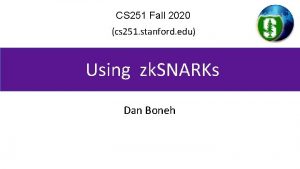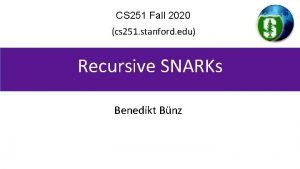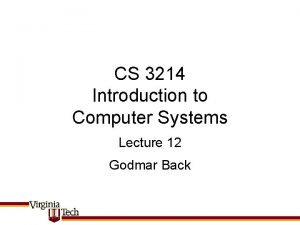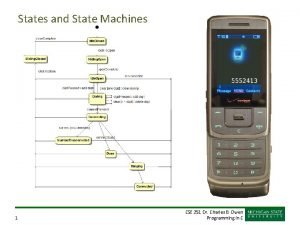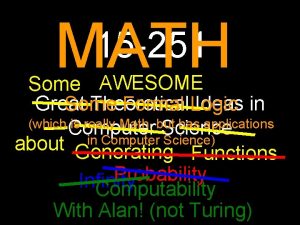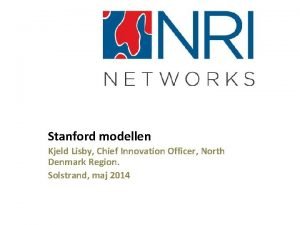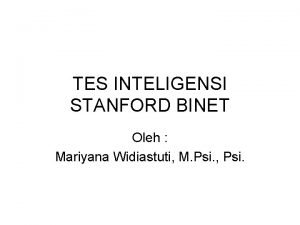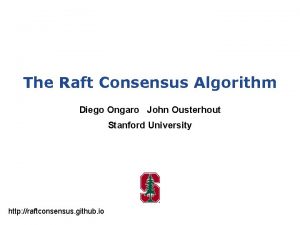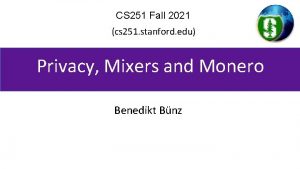CS 251 Fall 2021 cs 251 stanford edu


![An example: Name. Coin Domain name system on the blockchain: [google. com �IP addr] An example: Name. Coin Domain name system on the blockchain: [google. com �IP addr]](https://slidetodoc.com/presentation_image_h2/ac9fad2ae9a8ff4ae157dfff071cb332/image-3.jpg)









![Account state: persistent storage Every contract has an associated storage array S[]: S[0], S[1], Account state: persistent storage Every contract has an associated storage array S[]: S[0], S[1],](https://slidetodoc.com/presentation_image_h2/ac9fad2ae9a8ff4ae157dfff071cb332/image-13.jpg)












![An example contract: Name. Coin function name. Lookup(bytes 32 name) { } return data[name]; An example contract: Name. Coin function name. Lookup(bytes 32 name) { } return data[name];](https://slidetodoc.com/presentation_image_h2/ac9fad2ae9a8ff4ae157dfff071cb332/image-26.jpg)












- Slides: 38

CS 251 Fall 2021 (cs 251. stanford. edu) Ethereum: mechanics Dan Boneh Note: HW#2 is posted on the course web site. Due Oct. 18.

Limitations of Bitcoin Recall: UTXO contains (hash of) Script. PK • simple script: indicates conditions when UTXO can be spent Limitations: • Difficult to maintain state in multi-stage contracts • Difficult to enforce global rules on assets A simple example: rate limiting. My wallet manages 100 UTXOs. • Desired policy: can only transfer 2 BTC per day out of my wallet
![An example Name Coin Domain name system on the blockchain google com IP addr An example: Name. Coin Domain name system on the blockchain: [google. com �IP addr]](https://slidetodoc.com/presentation_image_h2/ac9fad2ae9a8ff4ae157dfff071cb332/image-3.jpg)
An example: Name. Coin Domain name system on the blockchain: [google. com �IP addr] Need support for three operations: • Name. new(Owner. Addr, Domain. Name): intent to register • Name. update(Domain. Name, new. Val, new. Owner, Owner. Sig) • Name. lookup(Domain. Name) Note: also need to ensure no front-running on Name. new()

A broken implementation Name. new() and Name. upate() create a UTXO with Script. PK: DUP HASH 256 <Owner. Addr> EQVERIFY CHECKSIG VERIFY <NAMECOIN> <Domain. Name> <IPaddr> <1> only owner can “spend” this UTXO to update domain data Contract: (should be enforced by miners) if domain google. com is registered, no one else can register that domain verify sig is valid ensure top of stack is 1 Problem: this contract cannot be enforced using Bitcoin script

What to do? Name. Coin: fork of Bitcoin that implements this contract (see also the Handshake, Chia projects) Can we build a blockchain that natively supports generic contracts like this? ⇒ Ethereum

Ethereum: enables a world of applications A world of Ethereum Decentralized apps (DAPPs) • New coins: ERC-20 interface to DAPP • De. Fi: exchanges, lending, stablecoins, derivatives, etc. • Insurance • DAOs: decentralized organizations Crypto. Punk #2890 • NFTs: Managing distinguished assets (ERC-721 interface) • Games, metaverse: assets managed on chain stateofthedapps. com, dapp. review

Bitcoin as a state transition system … world state updated world state UTXO 1 UTXO 2 input UTXO 1 UTXO 3 ⋮ Tx: UTXO 2 �UTXO 3 ⋮ Bitcoin rules: Fbitcoin : S × I �S S: set of all possible world states, I: set of all possible inputs s 0 ∈ S genesis state …

Ethereum as a state transition system Much richer state transition functions ⇒ one transition executes an entire program

Running a program on a blockchain (DAPP) … blockchain … Tx 1 state 0 program code state 1 Tx 2 state 2 … create a DAPP compute layer (executed by miners): The EVM consensus layer

The Ethereum system Layer 1 (ETHv 1): Po. W consensus. Block reward = 2 ETH + Tx fees (gas) avg. block rate = 15 seconds. ETHv 1: variant of Nakamoto Po. W ETHv 2: proof of stake consensus about 150 Tx per block.

Ethereum compute layer: the EVM World state: set of accounts identified by 32 -byte address. Two types of accounts: (1) owned accounts: controlled by ECDSA signing key pair (PK, SK). SK signing key known only to account owner (2) contracts: controlled by code set at account creation time, does not change

Data associated with an account Account data Owned Contracts address (computed): Creator. Nonce) code: H(PK) H(Creator. Addr, ⊥ Code. Hash storage root (state): ⊥ Storage. Root balance (in Wei): balance nonce: nonce (1018 Wei = 1 ETH) (#Tx sent) + (#accounts created): anti-replay mechanism
![Account state persistent storage Every contract has an associated storage array S S0 S1 Account state: persistent storage Every contract has an associated storage array S[]: S[0], S[1],](https://slidetodoc.com/presentation_image_h2/ac9fad2ae9a8ff4ae157dfff071cb332/image-13.jpg)
Account state: persistent storage Every contract has an associated storage array S[]: S[0], S[1], … , S[2256 -1]: each cell holds 32 bytes, init to 0. Account storage root: Merkle Patricia Tree hash of S[] • Cannot compute full Merkle tree hash: 2256 leaves S[000] = a S[010] = b S[011] = c S[110] = d 0 0 root 1 10, d 0, a 0 ⊥, b time to compute root hash: ≤ 2×|S| 1 ⊥, c |S| = # non-zero cells 1

State transitions: Tx and messages Transactions: signed data by initiator • To: 32 -byte address of target (0 �create new account) • From, [Signature]: initiator address and signature on Tx (if owned) • Value: # Wei being sent with Tx • Tx fees (EIP 1559): gas. Limit, max. Fee, max. Priority. Fee (later) • if To = 0: create new contract code = (init, body) • if To ≠ 0: data (what function to call & arguments) • nonce: must match current nonce of sender (prevents Tx replay)

State transitions: Tx and messages Transaction types: owned �owned: transfer ETH between users owned �contract: call contract with ETH & data

Example From To (block #10993504) msg. value Tx fee (ETH)

Messages: virtual Tx initiated by a contract Same as Tx, but no signature (contract has no signing key) contract �owned: contract sends funds to user contract �contract: one program calls another (and sends funds) One Tx from user: can lead to many Tx processed. Composability! Tx from owned addr �contract �another contract �different owned

Example Tx world state (four accounts) updated world state

An Ethereum Block Miners collect Txs from users ⇒ leader creates a block of n Tx • Miner does: • for i=1, …, n: execute state change of Txi sequentially (can change state of >n accounts) • record updated world state in block Other miners re-execute all Tx to verify block • Miners should only build on a valid block • Miners are not paid for verifying block (note: verifier’s dilemma)

Block header data (simplified) (1) consensus data: parent hash, difficulty, Po. W solution, etc. (2) address of gas beneficiary: where Tx fees will go (3) world state root: updated world state Merkle Patricia Tree hash of all accounts in the system (4) Tx root: Merkle hash of all Tx processed in block (5) Tx receipt root: Merkle hash of log messages generated in block

The Ethereum blockchain: abstractly prev hash … … accts. updated world state Tx log messages

Amount of memory to run a node (in GB) ≈1 TB ETH total blockchain size: 8. 6 TB (Oct. 2021)

An example contract: Name. Coin contract name. Coin { struct name. Entry { address owner; bytes 32 value; } // Solidity code (next lecture) // address of domain owner // IP address // array of all registered domains mapping (bytes 32 => name. Entry) data;

An example contract: Name. Coin function name. New(bytes 32 name) { // registration costs is 100 Wei }} if (data[name] == 0 && msg. value >= 100) { data[name]. owner = msg. sender // record domain owner emit Register(msg. sender, name) // log event Code ensures that no one can take over a registered name Serious bug in this code! Front running. Solved using commitments.

An example contract: Name. Coin function name. Update( bytes 32 name, bytes 32 new. Value, address new. Owner) { // check if message is from domain owner, // and update cost of 10 Wei is paid if (data[name]. owner == msg. sender && msg. value >= 10) { }}} data[name]. value = new. Value; data[name]. owner = new. Owner; // record new value // record new owner
![An example contract Name Coin function name Lookupbytes 32 name return dataname An example contract: Name. Coin function name. Lookup(bytes 32 name) { } return data[name];](https://slidetodoc.com/presentation_image_h2/ac9fad2ae9a8ff4ae157dfff071cb332/image-26.jpg)
An example contract: Name. Coin function name. Lookup(bytes 32 name) { } return data[name]; } // end of contract

EVM mechanics: execution environment Write code in Solidity (or another front-end language) ⇒ compile to EVM bytecode (some projects use WASM or BPF bytecode) ⇒ miners use the EVM to execute contract bytecode in response to a Tx

The EVM Stack machine (like Bitcoin) but with JUMP • max stack depth = 1024 • program aborts if stack size exceeded; miner keeps gas • contract can create or call another contract In addition: two types of zero initialized memory • Persistent storage (on blockchain): SLOAD, SSTORE (expensive) • Volatile memory (for single Tx): MLOAD, MSTORE (cheap) see https: //ethervm. io/ • LOG 0(data): write data to log

Every instruction costs gas, examples: SSTORE addr (32 bytes), value (32 bytes) • zero �non-zero: 20, 000 gas • non-zero �non-zero: 5, 000 gas • non-zero �zero: 15, 000 gas refund (for a cold slot) Refund is given for reducing size of blockchain state SELFDESTRUCT addr: kill current contract (in the past: 24, 000 gas refund) CREATE : 32, 000 + 200×(code size) gas CALL gas, addr, value, args

Gas calculation Why charge gas? • Tx fees (gas) prevents submitting Tx that runs for many steps. • During high load: miners choose Tx from the mempool that maximize their income. Old EVM: (prior to EIP 1559, live on 8/2021) • Every Tx contains a gas. Price ``bid’’ (gas �Wei conversion price) • Miners choose Tx with highest gas. Price (max sum(gas. Price×gas. Limit)) � not an efficient auction mechanism (first price auction)

Gas prices spike during congestion Gas. Price in Gwei: 86 Gwei = 86× 10 -9 ETH Average Tx fee in USD

Gas calculation: EIP 1559 Every block has a “base. Fee”: the minimum gas. Price for all Tx in the block base. Fee is computed from total gas in earlier blocks: • earlier blocks at gas limit (30 M gas) �base fee goes up 12. 5% • earlier blocks empty �base fee decreases by 12. 5% interpolate in between If earlier blocks at “target size” (15 M gas) �base fee does not change

Gas calculation EIP 1559 Tx specifies three parameters: • gas. Limit: max total gas allowed for Tx • max. Fee: maximum allowed gas price (max gas �Wei conversion) • max. Priority. Fee: additional “tip” to be paid to miner Computed gas. Price bid: gas. Price �min(max. Fee, base. Fee + max. Priority. Fee) Max Tx fee: gas. Limit × gas. Price

Gas calculation (1) if gas. Price < base. Fee: abort (2) If gas. Limit×gas. Price < msg. sender. balance: abort (3) deduct gas. Limit×gas. Price from msg. sender. balance (4) set Gas �gas. Limit (5) execute Tx: deduct gas from Gas for each instruction if at end (Gas < 0): abort, Tx is invalid (miner keeps gas. Limit×gas. Price) (6) Refund Gas×gas. Price to msg. sender. balance (7) gas. Used �gas. Limit – Gas (7 a) BURN gas. Used× base. Fee (7 b) Send gas. Used×(gas. Price – base. Fee) to miner

Burn results in practice block reward (2 ETH) – Total base. Fee burned in block base. Fee for block (Wei) high base. Fee period high burn … sometimes burn exceeds block rewards �ETH deflation watchtheburn. com

Why burn ETH ? ? ? EIP 1559 goals (informal): • users incentivized to bid their true utility for posting Tx, • miners incentivized to not create fake Tx, and • disincentivize off chain agreements. Suppose no burn (i. e. , base. Fee given to miners): � in periods of low Tx volume miners would try to increase volume by offering to refund the base. Fee off chain to users.

Note: transactions are becoming more complex Gas usage is increasing ⇒ each Tx takes more instructions to execute

END OF LECTURE Next lecture: writing Solidity contracts
 Cs 251 stanford
Cs 251 stanford Cs 251 stanford
Cs 251 stanford Cs 251 stanford
Cs 251 stanford Highwire stanford edu
Highwire stanford edu Cs 3214 fall 2021
Cs 3214 fall 2021 Ucla fall 2021
Ucla fall 2021 Cos318 fall 2021
Cos318 fall 2021 Cos 318°
Cos 318° Tgfoa
Tgfoa Edu.sharif.edu
Edu.sharif.edu Hino a vida tem tristezas mil
Hino a vida tem tristezas mil Cse251
Cse251 Half lap muff coupling drawing
Half lap muff coupling drawing 15-251
15-251 Legge 251 del 2000
Legge 251 del 2000 15 251
15 251 15-251
15-251 Aae 251
Aae 251 Aecp fy 2023
Aecp fy 2023 Edu.ro programe scolare 2020-2021
Edu.ro programe scolare 2020-2021 Respect teachers
Respect teachers Karel the robot learns java
Karel the robot learns java Stanford
Stanford Stanford modellen
Stanford modellen Sherlock stanford
Sherlock stanford Mark kasevich
Mark kasevich Susie phillips stanford cheerleader
Susie phillips stanford cheerleader Kindergarten achievement test
Kindergarten achievement test Contoh tes stanford binet
Contoh tes stanford binet Alex hoffer stanford
Alex hoffer stanford Stanford exploration project
Stanford exploration project Ann dohn stanford
Ann dohn stanford Cs321 stanford
Cs321 stanford Cs 148 stanford
Cs 148 stanford Abhinav agarwal stanford
Abhinav agarwal stanford Diego ongaro stanford
Diego ongaro stanford Cs155
Cs155 Stanford prison experiment consent form
Stanford prison experiment consent form Stanford design thinking process
Stanford design thinking process
